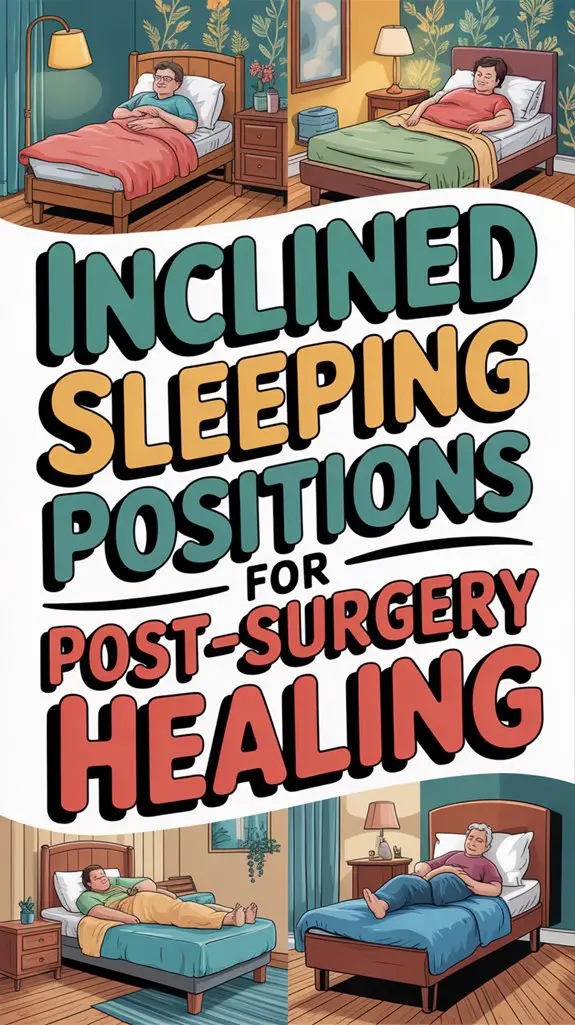Inclined sleeping positions are a total game changer after surgery! I can’t tell you how much it helped me.
After my operation, I tried sleeping at a 30 to 45-degree angle. Honestly, it felt like a cozy hug for my body. Less pressure on those sensitive incisions? Yes, please!
I remember one night specifically. I woke up and realized my swelling had gone down quite a bit. It was like magic! A wedge pillow became my best friend.
At Corala Blanket, we’re all about promoting better sleep. Have you ever experimented with these angles? I promise, it can make a world of difference. Let’s chat about our recovery journeys and enhance our sleep together!
Table of Contents
Quick Takeaways
- An inclined angle of 30 to 45 degrees reduces pressure on incisions and enhances drainage post-surgery.
- Using wedge pillows or adjustable beds helps maintain the necessary elevation for optimal recovery.
- Specific positions, like semi-Fowler’s for cardiac patients or head elevation for neurosurgery, support healing.
- Elevating the upper body improves circulation, decreases swelling, and alleviates pain during recovery.
- Consult healthcare providers for personalized recommendations on inclined sleeping positions based on the type of surgery.
Benefits of Inclined Sleeping Post-Surgery

When you’ve just had surgery, the last thing you want is to put extra stress on your healing body, right?
Inclined sleeping positions can be a game-changer. They reduce direct pressure on incisions, keeping your skin intact while facilitating ideal drainage. Research indicates that inclined bed therapy can lead to better outcomes in recovery.
Imagine this: less swelling means you’d feel more comfortable and experience less pain. Proper sleep positions enhance healing by alleviating pressure on the surgical site.
These recovery strategies not only enhance circulation but also support respiration. Elevating those legs can also help you sleep better, which is vital for healing. Trust me, mastering those pain alleviation techniques and finding the right angle can speed up your comeback like nothing else!
Recommended Angles and Positions
Finding the right sleeping angle can truly make a difference for your recovery after surgery, and I’m here to guide you through it! For ideal elevation, aim for an inclined angle of 30 to 45 degrees. This helps reduce swelling and improves circulation—it’s like giving your body a high-five! Additionally, maintaining an upright position can aid in decreasing the risk of complications post-surgery. You might want to use wedge pillows or recliners to keep that angle consistent during the night. It’s essential to wear your sling to maintain shoulder alignment while you rest. Recall, keeping your entire upper body elevated, not just your head, is key.
Specific Surgical Contexts

After figuring out the right angles and positions for sleeping, let’s talk about how these guidelines can change depending on the type of surgery you’ve had.
For orthopedic surgeries, like knee or spinal repairs, elevating your legs reduces swelling—definitely a win in your post-surgery recovery!
Cardiac patients thrive in a semi-Fowler’s position, ensuring lungs can expand like a power-up! It’s important to remember that upper airway surgery may also necessitate certain sleeping positions to maintain airway stability.
And hey, if you’ve had neurosurgery, keeping your head elevated helps with intracranial pressure.
Surgical positioning is key, so pay attention to the specifics, and your recovery could be smoother than you think!
Want more tips? Let’s explore!
Practical Implementation

Let’s explore the world of inclined sleeping positions, shall we? Implementing these strategies can turn your recovery into a more comfortable journey.
Here’s a quick reference:
| Implementation Method | Description |
|---|---|
| Adjustable Beds | Precise angle adjustments |
| Wedge Cushions | Convenient incline on demand |
| Bed Risers | Elevate the entire bed |
| Supportive Pillows | Maintain comfortable positions |
These sleeping aids will help you find your ideal comfort levels. Start low and work your way up, adjusting as needed. Consult your healthcare provider, and soon you’ll feel powerful and thriving! Additionally, using inclined sleeping positions can help decrease acid reflux symptoms, promoting better overall rest during recovery.
FAQ
How Long Should I Sleep in an Inclined Position After Surgery?
I suggest you sleep in an inclined position for at least 24 to 48 hours post-surgery. Following your recovery timeline helps guarantee ideal healing, so adjust the sleep duration based on your specific procedure.
Can I Use Regular Pillows Instead of a Wedge Cushion?
Using regular pillows instead of a wedge cushion is like trusting a flimsy bridge when crossing a river. Wedge benefits, like stability and elevation, make them far superior pillow alternatives during recovery. Comfort matters!
What if I Accidentally Roll Onto My Stomach at Night?
If I accidentally roll onto my stomach at night, I quickly shift back to an elevated position. Using sleep support like pillows really helps. I rely on recovery tips to keep my healing on track.
Are There Any Activities I Should Avoid While Sleeping Inclined?
When I learned to sail, I realized the importance of balance. Likewise, while sleeping inclined, I avoid activities that disrupt body alignment, like twisting or sudden movements. Sleep aids, like supportive pillows, help me stay aligned.
Will Sleeping Inclined Affect My Overall Sleep Quality?
Absolutely, sleeping inclined enhances my sleep quality. The inclined benefits include fewer interruptions, better restorative stages, and improved circulation, allowing me to wake up feeling refreshed and energized, ready to tackle the day ahead.
References
- https://airpedic.com/benefits-of-sleeping-with-head-elevated/
- https://iskandarcenter.com/hernia-surgery/what-is-the-best-position-to-sleep-after-hernia-surgery/
- https://specialtysurgerycenter.org/best-sleeping-positions-after-surgery/
- https://drlplasticsurgery.com/blog/tummy-tuck-sleep-side/
- https://www.synergyplasticsurgery.com/blog/sleeping-positions-after-breast-augmentation/
- https://sleepagainpillows.com/blogs/surgery-recovery-resources/inclined-bed-therapy
- https://sleepagainpillows.com/blogs/surgery-recovery-resources/sleeping-positions-after-lung-surgery
- https://www.powernap-ltd.co.uk/adjustable-beds-for-post-surgery-recovery-support-and-comfort-tips/
- https://jointreplacementcenterscottsdale.com/blog/sleeping-positions-after-hip-replacement/
- https://sleepnitez.com/post-surgery-recovery/
- https://www.davidpassarettimd.com/blog/2020/02/03/sleeping-position-after-breast-augmentation-203681/
- https://pmc.ncbi.nlm.nih.gov/articles/PMC8124518/
- https://sleepagainpillows.com/blogs/surgery-recovery-resources/why-do-doctors-recommend-sleeping-elevated-after-mastectomy
- https://warnockmd.com/recommended-sleeping-strategies-rotator-cuff-surgery/
- https://progressiveoralsurgery.com/p/BLOG-67498-2019.12.15-Can-Sleeping-on-an-Incline-After-Oral-Surgery-Help-With-Healing-p.asp
- https://www.davidmbutlermd.com/blog/how-long-should-you-sleep-with-your-head-up-after-a-facelift/
- https://www.tannanplasticsurgery.com/best-sleeping-position-after-plastic-surgery/
- https://www.youtube.com/watch?v=IfgbCOAl3XI
- https://pmc.ncbi.nlm.nih.gov/articles/PMC7435437/
- https://afpent.com/airway-throat/surgery-for-snoring-sleep-apnea/
- Mood Makers: Small Details That Transform a Room - October 17, 2025
- Why Ancient Civilizations Elevated Their Beds - October 17, 2025
- Why Elevate Your Bed With Wooden Blocks? - October 17, 2025

